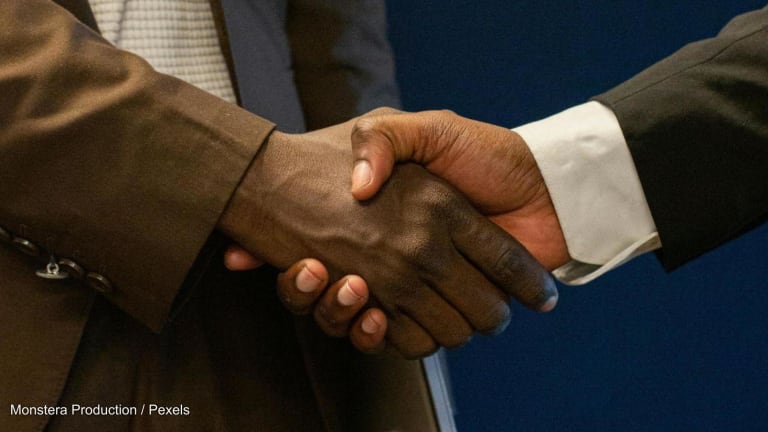Q&A: Tom Dente on mergers in the development sector
Three organizations in the international development sector have merged to create Humentum, a new organization focused on providing operational capacity-building services to international NGOs. CEO Tom Dente spoke with Devex about the process and benefits of merging organizations in the development sector.
Three organizations officially merged today to create Humentum, a new nonprofit focused on providing operational capacity-building services for development, humanitarian, civil society and other international social sector organizations. The two U.S. organizations, InsideNGO and LINGOs, will be registered as one NGO, with the U.K.-registered charity MANGO as a legal affiliate. Humentum plans to integrate the core capabilities of each organization into its new operations. InsideNGO is made up of 330 international NGOs and experts providing advice and trainings to the sector. LINGOs, also a capacity-building organization, focuses on eLearning. MANGO is a charity aimed at improving financial management and accountability for development and humanitarian NGOs and their partners. The new organization hopes to leverage LINGOs’ foundation in digital learning to scale its training content and curriculum. MANGO will meanwhile provide expertise in navigating DfID funding sources, which will complement InsideNGO’s expertise in USAID. The three organizations have previously collaborated — an experience that both inspired and facilitated their merger, according to Tom Dente, who served as the president and CEO of InsideNGO since 2016 and will become the new CEO of Humentum. The new Humentum members were part of a group that developed Financial Management for the Development Professional, or FMD Pro, a certification-based, sector-wide standard for nonfinancial managers. PMD Pro, a project management certification for development professionals, was developed by LINGOs. Dente, who joined InsideNGO in 2011 from consulting firm Bain & Company and A.T. Kearney, spoke with Devex about the process and benefits of merging organizations in the development sector. Our conversation has been edited for length and clarity. How was it decided that joining InsideNGO, LINGOs and MANGO was a good strategic move for all three organizations? We began discussions back in March 2016 to look for ways for us to collaborate more. We had worked together individually, and as we started those conversations, we began to say, what more could be possible? Could we move beyond just pure collaboration to something which would really fundamentally allow us to deliver on a broader mission and to sustain that mission? We all entered this from a position of knowing each other individually as organizations with some of our past collaborations. We had a good rapport of trust built up. I think we were able to accelerate those conversations, given that. We really quickly got to some of the strategic and the broader issues, given that we had that past history of collaboration. What were the benefits and drawbacks that your organization, InsideNGO, weighed before making this decision? The positives were there right from the beginning. We would have more critical mass; we would have larger communities of practice; we would have deeper expertise around a number of operational issues; we would have deeper expertise around funder requirements, like USAID or DfID. We would have a wide-ranging pool of people who we would draw upon, who are partners of each of our individual organizations. In terms of some of the drawbacks, we have all been autonomous organizations, meaning that we all had our own identities and our own affiliations. We had to be able to move beyond that and say, we can put our identity behind us and really think about this as the next step ahead. I think what made it helpful is that my two counterparts — Tim Boyes-Watson from MANGO, and Chris Proulx from LINGOs — are both experienced leaders and they really put the mission above themselves. They will be an important part of our leadership team in the future, and what we were doing was more important than necessarily them maintaining an overall leadership role. I think it was that spirit of trust and spirit of collaboration for the greater mission that overcame any concerns individuals or organizations may have had around giving up that autonomy that we all enjoyed as individual organizations. Is carrying out a merger in the development sector different than in other sectors? I think what makes it slightly different is that often in the commercial sector, you may be able to move more quickly, or the stakeholder ownership isn’t as important. Because InsideNGO and LINGOs are membership organizations, we feel a special responsibility to our members to make sure we are acting in their best interest when we make larger strategic moves. Also for MANGO — as a nonprofit serving the sector — it takes its obligations to serve its clients very well too. I think there was the strong sense of making sure we do this the proper way for our members and recognize that it’s that trust that we have in our sector that allows us to be successful. We had to spend the right time to make sure everything we were doing aligned with that. Why do you think mergers are rare in the development sector? You are somewhat limited if you just look within the four walls of your own organization. If you start to broaden that look, and say, if we collaborate with this organization, or potentially if we merged with this organization, we could do even more. I think that changes your mindset in terms of what is possible. I think what’s made it hard in some ways is that it’s very easy for all of us to believe that what we do is very unique. That we have a unique insight, a unique ability to deliver, or a unique strategy. I think that more and more we will see organizations look for ways to say that’s true, but we can do even more with that uniqueness by collaborating more, by merging. Most of my career has been in the commercial sector. I think in the commercial sector, it’s very challenging. There are issues of control, issues of logos and identity. There are issues of who takes on which role in the combined organization. That’s hard. It’s hard to address all of those issues. What gives me a lot of confidence in the international development and humanitarian sector is that because it is so mission-focused, it can overcome a lot of those traditional barriers of control — who has which role, identity, branding and logos. This sector is bigger than all of that, and that’s why I think in the future we will probably see more of it. What challenges has your organization faced during the merger? We have to create a combined culture. We have a set of stories that we’ve had, how we’ve worked together, communications. We are spending a lot of time making sure we get the culture right. Making sure the culture of our new organization brings the best of what we’ve seen of our past organizations. Did you ever have any doubts that this was the right move for your organization? We started talking about it in March 2016. It was before Brexit and before the U.S. election and all of the changes in our broader environment since then, as well as the growing scale of humanitarian challenges in our world. Given that our external environment continued to shift, creating new pressures and new challenges to NGOs and actors involved in the humanitarian and development area, we became even more convinced as we moved along that we could add more value, given all the new pressures — that this was really a time for us to step up. What advice would you give other organizations considering a similar path? Focus on the mission first. When you think about the possibilities for merger or collaboration, the key question is, how can we accelerate what we are doing strategically? How can it accelerate our mission? Secondly, to be successful, it takes the trust and involvement of senior leaders across the organizations. Make sure the right time is invested in creating that trust and that senior leaders are involved in order to really understand what’s possible — and then, more importantly, how to execute it. Then, use the right external advisors, at the right stage of the process. We were fortunate to have several who helped us. I think that being able to draw upon advisors in that way really helped make this whole process successful. Read more international development news online, and subscribe to The Development Newswire to receive the latest from the world’s leading donors and decision-makers — emailed to you free every business day.
Three organizations officially merged today to create Humentum, a new nonprofit focused on providing operational capacity-building services for development, humanitarian, civil society and other international social sector organizations. The two U.S. organizations, InsideNGO and LINGOs, will be registered as one NGO, with the U.K.-registered charity MANGO as a legal affiliate.
Humentum plans to integrate the core capabilities of each organization into its new operations. InsideNGO is made up of 330 international NGOs and experts providing advice and trainings to the sector. LINGOs, also a capacity-building organization, focuses on eLearning. MANGO is a charity aimed at improving financial management and accountability for development and humanitarian NGOs and their partners.
The new organization hopes to leverage LINGOs’ foundation in digital learning to scale its training content and curriculum. MANGO will meanwhile provide expertise in navigating DfID funding sources, which will complement InsideNGO’s expertise in USAID.
This story is forDevex Promembers
Unlock this story now with a 15-day free trial of Devex Pro.
With a Devex Pro subscription you'll get access to deeper analysis and exclusive insights from our reporters and analysts.
Start my free trialRequest a group subscription Printing articles to share with others is a breach of our terms and conditions and copyright policy. Please use the sharing options on the left side of the article. Devex Pro members may share up to 10 articles per month using the Pro share tool ( ).
Sara Jerving is a Senior Reporter at Devex, where she covers global health. Her work has appeared in The New York Times, the Los Angeles Times, The Wall Street Journal, VICE News, and Bloomberg News among others. Sara holds a master's degree from Columbia University Graduate School of Journalism where she was a Lorana Sullivan fellow. She was a finalist for One World Media's Digital Media Award in 2021; a finalist for the Livingston Award for Young Journalists in 2018; and she was part of a VICE News Tonight on HBO team that received an Emmy nomination in 2018. She received the Philip Greer Memorial Award from Columbia University Graduate School of Journalism in 2014.








